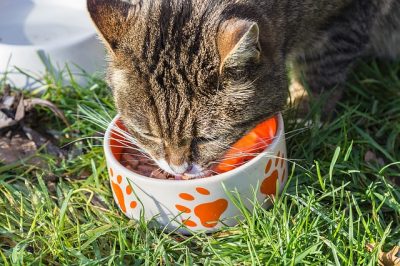
Cats can have a variety of reasons for eating too fast and finishing their meals in seconds. When a cat gobbles its food like it’s the last meal it will ever have, it’s not just a quirky habit—it can lead to health problems. One common consequence of this behavior is regurgitating food right after eating. If your cat regularly vomits after eating, even after you’ve tried slowing down its eating, it’s important to visit the vet to rule out any underlying health issues.
Why Does a Cat Eat Too Fast?
There are several reasons why a cat might eat too quickly and then vomit its food. Understanding the cause is the first step to helping your cat develop better eating habits and avoid health complications.
1. A Food-Obsessed Cat
Some cats simply love to eat. If your cat devours its food the moment you put it down, it may have an obsession with food. Food-obsessed cats are at risk for obesity and diabetes since they tend to eat large amounts quickly and frequently. If your cat is chubby and inhaling its food, it’s time to adjust its diet and re-educate its eating behavior.
2. Food Competition
Food competition creates conflict between cats and can lead to unhealthy eating habits. In multi-cat households, the dominant cat takes over the food, which creates a sense of urgency for the other cat to eat quickly before the food is gone. This can cause the fast-eating cat to overeat and regurgitate. However, in some cases, food-related stress may have the opposite effect, causing the more submissive cat to withdraw and eat less, which can lead to depression in cats.
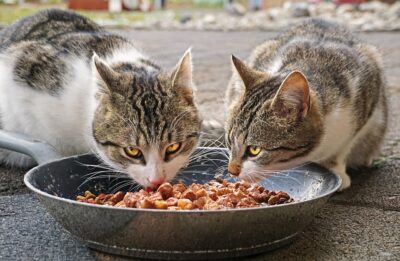
3. Rescued Cats
Cats that have experienced food scarcity or starvation, such as orphaned or rescued street cats, often develop a tendency to eat rapidly once they have consistent access to food. This behavior stems from the cat’s survival instinct, where eating quickly increases the chance of securing enough food before it disappears. Veterinary professionals commonly observe this behavior in rescued cats, particularly those that have experienced prolonged food insecurity.
4. Infrequent Feeding Schedule
Cats naturally prefer to eat small, frequent meals throughout the day. Feeding a cat only once or twice a day can cause excessive hunger, making them more likely to eat too fast when food becomes available. Imagine not eating all day and then trying to eat an entire meal in one sitting—your cat feels the same way!
Consequences of a Cat Eating Too Fast
Eating too fast doesn’t just lead to discomfort—it can cause real health issues for your cat. Here’s what can happen when your cat gobbles down its food too quickly:
Regurgitation
A cat’s digestive system is not designed to handle large amounts of food at once. Because a cat’s esophagus is positioned more horizontally than in humans, food may not pass as smoothly into the stomach when eaten too quickly. This can cause food to back up into the esophagus, leading to the regurgitation of undigested food shortly after eating.
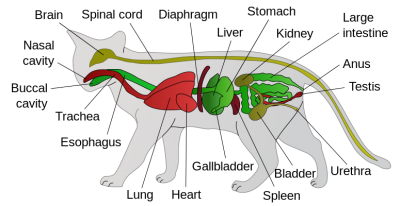
Stomach Pain and Discomfort
When a cat inhales its food too quickly, it also swallows excess air, which can lead to bloating and stomach cramps. This discomfort may cause the cat to avoid eating altogether or increase irritability.
Increased Risk of Obesity
Fast eaters tend to consume more food than they actually need. Over time, this can lead to obesity and related health problems, including diabetes and joint issues.
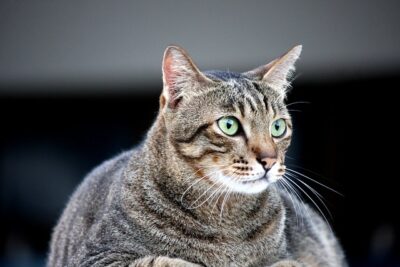
Choking Hazard
Inhaling food without properly chewing it increases the risk of choking. A piece of kibble or food that is too large can become lodged in the cat’s throat, causing a dangerous situation.
How to Stop a Cat from Eating Too Fast
Fortunately, there are several effective ways to help your cat slow down when eating. The best solution depends on whether you have a single cat or a multi-cat household.
1. Reduce Food Competition
If you have multiple cats and one of them tends to inhale its food and then vomit, food competition is likely the cause. In my article how to stop a cat from eating the other cat’s food I explain how to apply methods to separate your cats when eating to avoid this issue. You can reduce food competition by:
- Feeding cats in separate rooms.
- Using separate feeding stations.
- Creating a routine where each cat gets its own feeding time without stress.
- Separating cats at mealtime will allow each one to eat calmly and prevent the dominant cat from overeating. This will also help the fast eater maintain a healthier weight.
2. Use Slow Feeding Bowls
Slow feeding bowls are designed to slow down a cat’s eating pace by making it more challenging for the cat to access the food. These bowls typically feature raised obstacles or patterns that prevent the cat from grabbing large mouthfuls of food at once. Here are some effective slow feeding bowls:
- Northmate Interactive Slow Pet Feeder – This feeder has raised prongs that make the cat work to reach the kibble, which slows down eating. It’s durable, easy to clean, and great for both wet and dry food.
- Tiger Diner Ceramic Bowl – This bowl is designed with holes around from where your cat has to introduce its paw and get the food out.
- Elevated Slow Feeder Bowls – Elevated slow feeding bowls position the food at a more natural angle for digestion, reducing regurgitation and promoting better posture while also slowing down your cat when eating. They are available in plastic, ceramic, and stainless steel options. Ceramic and stainless steel are more hygienic and better suited for cats with allergies or sensitivities to plastic. The designs often feature patterns or dividers that force the cat to eat more slowly.
3. Use Feeding Puzzles
A study published in the Journal of Feline Medicine and Surgery found that using food puzzles and interactive toys can help reduce fast eating and excessive food-seeking behavior in cats. Feeding puzzles challenge your cat to use its paws or problem-solving skills to extract food from the toy. These toys stimulate natural hunting behavior while slowing down eating. Here are some effective feeding puzzles:
- Trixie Mad Scientist Cat Toy – A puzzle toy with rotating beakers that your cat must flip to release the kibble or treats, providing mental stimulation and slowing down eating.
- Trixie 5-in-1 Cat Activity Board – A multi-activity board that combines tunnels, prongs, and compartments, encouraging the cat to solve different challenges to access the food. It offers mental stimulation and helps prevent boredom.
- Trixie Tunnel – A tunnel-based toy that hides food inside, encouraging the cat to “hunt” for its meal. This engages a cat’s natural hunting instincts and prevents gobbling. Check my list of toy food dispensers reviews for more feeding puzzles.
You can also make DIY slow feeding toys using a refrigerator egg tray—it worked really well with my cat. An ice cube tray works great too! Watch the following video:
Watch my cat eating with an improvised slow feeding tray
4. Use Interactive Toys
Interactive toys combine feeding with play, encouraging the cat to move and work for its food. These toys help burn off energy while preventing overeating. Here are some effective interactive toys:
- Slimcat Ball Toy – A ball that dispenses kibble as the cat bats it around. This encourages exercise and helps control portion size.
- Trixie Snack Roll – A rolling toy where the cat must push it around to release food. It provides both physical and mental stimulation.
- Funkitty Egg-Cersizer – An egg-shaped toy that dispenses food when the cat bats it. The adjustable openings allow you to control the difficulty level.
- Hagen Catit Ball – A lightweight ball that dispenses treats or kibble as the cat rolls it. This toy is easy to clean and encourages playful feeding. Check my list of treat & food dispensing toys reviews for more toys.
5. Spread Out Meals Using Digital Automatic Feeders
Digital automatic feeders are an excellent way to control portion size and prevent fast eating. These feeders can be programmed to dispense small amounts of food at regular intervals, allowing you to break down a full meal into smaller portions spread out within 10 or 15 minutes. This prevents your cat from inhaling large amounts of food all at once, reducing the risk of choking and regurgitation.
The PortionPRO RX and Petlibro Automatic Feeder can dispense as little as 10–15 g at a time and up to 6 meals per day. If you need more than 6 meals, the Feeder Robot allows for unlimited feedings—but its minimum portion size is 1/8 cup (about 14–15 g), which may be too large for cats prone to regurgitation. In that case, pairing a high-frequency feeder with a slow feeder or puzzle toy can help slow down eating effectively.
6. Use a Lick Mat
Lick mats are textured rubber mats designed to hold wet food, treats, or soft cat food. The textured surface forces your cat to lick the food slowly to extract it, which naturally slows down eating. Licking also has a calming effect on cats because it stimulates the release of endorphins, helping to reduce stress and anxiety. This approach engages both your cat’s tongue and brain, encouraging slower eating and providing mental stimulation.
7. Scatter Feeding
Instead of placing all the food in a bowl, try scattering it across the floor or on a feeding mat. This encourages your cat to “hunt” for the food, which mimics natural hunting behavior and slows down eating.
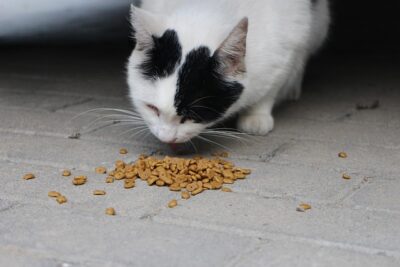
How to Introduce a Slow Bowl, Puzzle or Lick Mat to Your Cat
To introduce slow feeding puzzles, bowls, or mats, start by placing small amounts of kibble in the puzzle alongside the cat’s regular feeding bowl. Gradually increase the use of the puzzle until your cat becomes comfortable with the challenge. If your cat seems frustrated, try using an easier puzzle or mixing in high-value treats to encourage participation. This gradual approach will help your cat associate the puzzle with a positive experience and prevent stress during mealtime (source).
Final Thoughts
Helping a cat who eats too fast and then vomits may seem challenging, but with a little patience and the right strategies, you can improve your cat’s eating behavior. Whether you try using slow feeding bowls and interactive toy feeders, adjusting your cat’s feeding schedule, or using digital automatic feeders, slowing down your cat’s eating will lead to a healthier and happier pet—and fewer messes for you to clean up!
Some content contains affiliate links or samples for reviews; I may receive compensation. Learn more
Our short hair oriental vomits every several days his wet food. When he vomits it , it appears not to have been even chewed. I have tried spreading it around his dish and giving several really small portions and that helps, any suggestions for slowing down wet food eating .?
Hi Mary, thanks for your question. I suggest you spread out the wet food meal in several portions with a wet food feeder. The CatMate C500 offers four programmable compartments that are kept covered by a lid, and one exposed tray for the cat to eat the meal at present time. You can program a minimum of 10 minutes between each meal. If you spread out his meal into 3 parts, it will take 30 minutes to finish his meal. Another solution would be getting a slow feeder for wet food. Hope that helps!